The more neighborhood and political discourse doesn't change, the more things remain the same
I am pretty tired and disappointed I hate to say with regard to a lot that is going on in the city.
It's just the same old merry-go-round, things spinning in circles. Plus, I have written over 6,000 blog entries in the past 4.5 years, so I figure on most topics, I've already written what I think, and since my viewpoints stay pretty consistent, I don't necessarily have anything new to say (even though it is likely new to most anyone considering the issue). As the line in the song " Psychokiller" says "When I have nothing to say, my lips are sealed, say something once, why say again?" (Other songs that capture my ennui... "Sick of You" and "Chairman of the Bored" by Iggy Pop.)
Still the repetition and broken record stuff means that I do feel compelled to say things again, or at least reprint blog entries.
The blog We Love DC, in "Non-Applebees need not apply" reports on continued anti-"liquor" efforts, this time on Bladensburg Road in Ward 5 by the ever erstwhile Kathy Henderson. Thanks to Geoff for the heads up.
The funny thing is, this sounds exactly like the reaction to the plans by Joe Englert to seed a bunch of tavern and entertainment-oriented establishments on H Street NE "way back" in 2005. I was one of very few people at the time (then I was still on the ANC6C Planning and Zoning Committee) trying to point out a nuanced response, and making the point, a point that also eludes Ms. Henderson, that a Class A or Class B liquor license is likely to have a much more deleterious impact on a neighborhood compared to a Class C license.
Click here for my 2002 testimony on overconcentration of Class A and Class B licenses in the H Street neighborhood, "Local involvement is so much fun."
And you might be interested in these past entries:
- Revitalizing urban commercial districts requires many things (2007)
- Nightlife then and now... (2007)
- and points 1 and 2 in this entry, A myopic look back at 2006 from January 1, 2007

page 3 of the Post Weekend section, Friday 12/29/2006. Five years ago, would have you ever expected to read a plethora of positive articles about H Street NE in the local or national press?
And oh, with regard to H Street, ... I was right. People like Mark Borbely were not right.
This is a reprinting of a blog entry from April 2005:
Restaurants and liquor licenses--How much is too much on H Street?
The issue of liquor licenses on H Street NE continues to be contentious and has come up again because of the proposals by local restauranteur Joe Englert to open a "critical mass" number of establishments in the entertainment area of the corridor. Here is the thread, including my response, thus far.
From ANC6A Commissioner Mark Borbely:
A bar/tavern/nightclub developer, Joe Englert, presented proposals last night to bring 3 additional bars/taverns to the 1200 block of H Street and one to the 1300 block. This would be in addition to the two he's already applied for.
Here are some details on those bars/taverns that are in the pipeline, including the four (marked with an asterisk) that Mr. Englert described at last night's ANC liquor license committee meeting. I believe the licenses sought for all these would require 30% revenue from food:
- 1206 H St. The Olympic. Application already submitted. Old school neighborhood sports bar with full bar menu. An Englert establishment.
- 1210 H St. The Showbar. Application already submitted. Occasional live entertainment. An Englert establishment.
*- 1212 H St. The Red and the Black. Live music on 2nd floor. Bar on first floor. New Orleans style place. Capacity 120. An Englert establishment.
*- 1224 H St. The Beehive. Mexan food and grilled burritos. Summer garden in back. Capacity about 69. Some residential or office on second floor. Jukebox. An Englert establishment.
*- 1234 H St. name? Would sell chips and snack items. Capacity 79 or 89. Few booths. Pool table. Jukebox or prerecorded music. Beer with classic drinks. Mostly bottled beers and drinks like martinis. Applicant is actually a partner or friend of Mr. Englert's.
- 1236 H St. The Martini Lounge, at Martinis and other drinks. Two floors, with lounge downstairs and dance floor upstairs. Bar and lounge, serving American cuisine, with dance floor, live jazz band, DJ, for R&B Music, Hand Dancing, Salsa and Karaoke. Not a Joe Englert establishment, but this is also in the pipeline.
*- 1353 H St. The Rock and Roll Hotel. 7,000 square foot area. Capacity 349. Two levels. First level: 40s and 50s style grand hotel with big chandeliers. Bar would be like in a Hollywood movie. Upstairs: 12 separate rooms people could rent out for evening parties. Would feature heavy appetizers served as room service (with tray and cover). Would feature a lot of draft beers/microbreweries. An Englert establishment.
Is all this okay? There are obviously pros and cons: on the one hand, we want development; on the other, do we want this?
The new liquor license applications will likely be considered by the ANC's liquor license committee on May 17. The ANC has already voted to support the applications at 1206, 1210 and 1236 H. Applications can be legally protested, by the ANC or by individual residents, on the basis of impact on peace, order and quiet, among other things.
From ANC6A Commissioner Karen Wirt:
Six bars or taverns serving liquor within two blocks is outrageous. ANC commissioners have been fighting for years to keep liquor to a minimum on the H Street corridor. Even the best negotiated agreement and the most convincing presentation by a developer cannot prevent the damage this bar strip will cause to the surrounding residential neighborhood. Did anyone notice that there is a church there? And did anyone think about the patrons of these bars walking to their parked cars on neighboring streets at all hours of the night and into the morning? On the part of my constituents living close to the other end of the H Street corridor, we do not want this kind of disproportionate representation of bars and taverns to spread down the corridor.
I believe current practice by ABRA is to allow neighboring ANCs who might be negatively affected by a liquor license application to weigh in. Thus you can be sure that this proliferation of bars and taverns on H Street will be reviewed by ANC 6C. After all, both ANC 6A and ANC 6C have been working together to encourage an appropriate mix of businesses on H Street. This is hardly an appropriate mix for these two blocks; it is a mix with disastrous consequences for neighbors who live nearby; and approval of this bar strip sets a poor precedent for the H Street corridor.
From Richard Layman:
I do respectfully disagree with Commissioner Wirt on this, primarily because I don't think that Class C (restaurant) licenses should be judged in the same way as Class A (liquor) and Class B (beer and wine) licenses in terms of the impact on the community.
I have written a couple of weblog entries about this broad issue, about the importance of restaurants to revitalization, including "
Richard's Rules for Restaurant-Based Revitalization" and "Passion and Vision: The real building blocks of revitalization".
First, you have to remember that this "two block area" is actually the equivalent of five regular blocks, because the 1200 block is a double-block in length, and the 1300 block is a triple-block.
Second, this is really a form of retail clustering not any different than the "Restaurant Row" at 200-300 blocks of Massachusetts Ave. NE (Lounge 201, Armands, Brasserie, Two Quail, La Loma, Cafe Berlin, White Tiger, whatever goes into Red River Grill, and that Italian place on 300 block of D, + Schneiders and the beer and wine sales at the supermarket).
Similarly, the number of establishments on the 200 and 300 blocks of Pennsylvania Ave. SE, or on the 1500-1700 blocks of 17th Street NW, Barracks Row, etc.
Third, a friend of mine made a point to me a few years ago that really hit home. He goes to clubs and I don't really very much (as those of you who know me wouldn't find to be a surprise). He said "when you go out, you don't really go to a specific place as much as an area, because if the specific place you 'start at" isn't great, you're stuck with no other options. But if there are a number of places in a "district" you have more options and make a night of it--you won't get stuck.
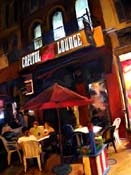
Photo by Robert McClintock (this and other DC photos are available for sale on the website).
I must disclose that I have had a conversation with Mr. Englert about his plans, and I regularly patronize one of his establishments (Capitol Lounge) for weekend breakfast. Before the impromptu "meeting" (I was going in for breakfast) I had heard secondhand about his plans and I thought they were a bit optimistic. After hearing him out, my response was "I have good ideas, but you have great ideas and I am usually the person in the room with the great ideas!"
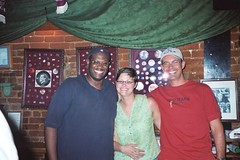
Carousing in the basement private room at Capitol Lounge (the great ideas I mentioned that Mr. Englert has go far beyond this...)
In short, I was convinced about the creativity and responsibility of his group's plans (and I was already knowledgeable about his track record and reputation of running quality establishments with few if any problems with the Police, ABRA, or the neighbors).
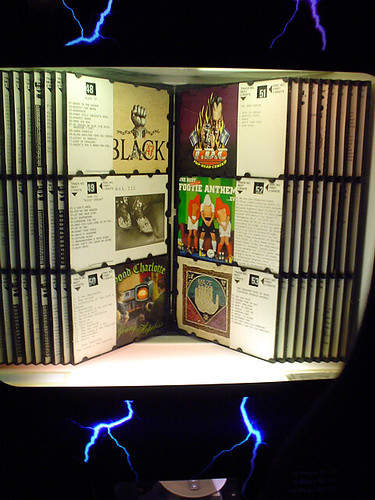
Englert establishments are known for particularly fine jukebox music selections; this photo is from Capitol Lounge.
WRT the point about the Church, when churches are on commercial strips, their perceived needs must be held secondary to the needs of the success of the commercial district, especially when at most, these buildings appear to be in use about 3-4 hours/week (out of 168) and generally at times when the commercial district is not in operation. In any case, when other establishments are in operation, general restrictions with regard to proximity to churches are obviated. (This sounds bad, but I think the 1300 block would be better off without the churches at the western end, as they appear to be hardly ever in use, even though I know that the pastor of St. John's has been supportive and involved in H Street revitalization activities over the years.)
This or this? You decide.
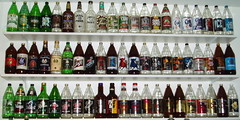
Usually consumed outside, in the public space, in a manner that often contributes to disorder. Photo from www.40ozMaltLiquor.com.
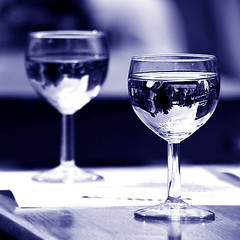
Wine, beer, and mixed drinks consumed inside a licensed managed establishment tend not to cause problems in commercial districts, even those that abut neighborhoods. Photo from stijn.vogels at Flickr.
In the context of the Zoning Commission hearing a couple weeks ago, questions were raised about the market study performed as part of the H Street Strategic Development Plan. One of the major points of the market study is that the current retail trade area (say from New York Avenue on the north to the SE-SW freeway on the south, North Capitol on the west and the Anacostia River on the east) is not large enough to support the extant 1 million square feet of retail commercial space.
H Street never was a commercial district that was majority focused on the immediate neighborhood. It was a regional shopping district--with one of the first 30 Sears stores in the United States, theaters, some of the earliest outposts of chains such as Peoples Drug, Kay Jewelers, Pep Boys, Giant Supermarkets, Hechingers, etc.--that was a major destination. It was not until the late 1940s that the suburbs had a department store and began supplanting the commercial districts in the city.
The major shopping districts in the region were Downtown, 14th Street (higher sales because it had more car dealerships, and cars cost a lot more than a clothing outfit...), H Street, and Alexandria.
In order to have successful businesses lease up and thrive in that one million square feet of retail space, you need to be able to attract people from outside the neighborhood. (I have written about this before and I know it's in the H Street DC archive under "destination marketing".) Their patronage will help bring and as importantly retain businesses in the community that the community says it wants. The Atlas Performing Arts Center and the H Street Playhouse will draw people to the area, but if they have nothing else to do, they will be "in and out" patrons, with little economic multiplier value in the immediate community.
It has been a struggle for H Street to attract business proprietors that know what they are doing (this is not a problem exclusive to H Street, and Kennedy Smith, the former director of the National Main Street Center, wrote a great article that I am certain I have put in the hstreetdc archives called "Main Street at 15" which explains the post-suburban migration economic dynamics of commercial districts like H Street). Joe Englert is someone who knows what's up. He runs quality businesses that last. I know people (important people) who left Phish Tea without being served (after waiting more than 90 minutes to get their food) because they had to go. How do you think that helps attract repeat customers?
Frankly, imho H Street needs Joe Englert more than he needs H Street (except that it is a relatively inexpensive tremendous opportunity for him, because he has vision and first-mover advantage).
One advantage H Street has over many of the other areas mentioned above, despite our lack of comparable residential density, is that we have entertainment destinations (H Street Playhouse, Atlas) with more to come. Barracks Row in particular will hit a plateau because when it comes down to it, all it has are restaurants (although if the restaurants can make it work, they will benefit from MLB baseball). H Street has more. And Joe Englert proposes to bring even more (and "more is more" not "less is more").
Creating a "district" with multiple options makes it more likely that the entire district will succeed. Otherwise, like my friend said "You go to a place that sucks and you're stuck, with nothing else to do, but go home."
I don't think we want that, do we?
__________________________
Qualifiers. First, I am well-known in the city for opposition to overconcentration of Class A and B sales, as well as for products (often referred to as "singles") that are most likely to be consumed in the public space. I have testified and written about this issue for more than four years, and was featured in an article in the Washington Post about it in August 2003.
People think that I am against the consumption of alcoholic beverages. Nope. What I am against is the deleterious consequences of consumption in the public space, and the demonstrated links between overconcentration of sales of alcoholic beverages and disorder. Drink all you want, just don't make it other people's problems. In short, consume inside.
Here's something else from a February blog entry: Communities in Washington State, Seattle and Tacoma in particular, in Oakland, CA and elsewhere have focused on alcohol consumption in the public space. This is something that I am pretty active on in DC. But again, it all depends on what the drivers-levers are in your particular situation. (Some citations on alcohol sales issues from the Institute for Alcohol Studies in the UK, click here; and this story from the Seattle Times, "Seattle may extend alcohol-sale limits to much larger area."
Second, I have written about negative impacts that come from the "late night economy". Here's a couple paragraphs from a March blog entry:
"Managing the Evening and Late Night Economy" is a big issue in the UK, although I don't think the government came up with the right solutions (allowing for 4 am bar closings, to spread out the times when people leave places, fails to recognize most people will stay to last call, and then come out and be "yobs", merely extending the resultant problems to a later hour, which was the common criticism of the Government actions by various local constituencies--meanwhile this point continues to be ignored by the national government).
The UK government has been more focused on the binge drinking culture of the under-35 crowd, rather than traffic congestion (i.e., one of the suggestions in a report I read was "one strategy to prevent people from fighting in line while waiting at carryouts would be to give them chocolate to munch on while they wait").
A House of Parliament sub-committee actually did a night-time walk, starting after 11 pm, in some of the areas in London where this continues to be a pressing issue. Here's a link to the final report, a pdf version, and the Government response.
Can you imagine this kind of responsiveness from elected and appointed officials in the U.S.? It makes me want to go to the UK for graduate school.
Third, another resource for late night management issues is the Responsible Hospitality Institute. They do some good work even though the website seems to be practically worthless at the moment.
Fourth, did you ever read any of the "Adventures of Frank", the guy with his cousin who was opening a restaurant in Mount Pleasant called the Red Bean? Well, Frank failed. One of the reasons is because he didn't focus, didn't really know what to do (in my opinion). Another reason was because they didn't get an alcohol license until late in the game. Restaurants often need such licenses, if only to be competitive with other establishments, and to be able to offer drinks to people who want them. To maximize satisfaction, most people going out to eat will choose a restaurant with a liquor license over one without, just to ensure that people who might want a drink are not denied.
Labels: arts-culture, civic engagement, commercial district revitalization, music-entertainment, nightlife economy



0 Comments:
Post a Comment
<< Home